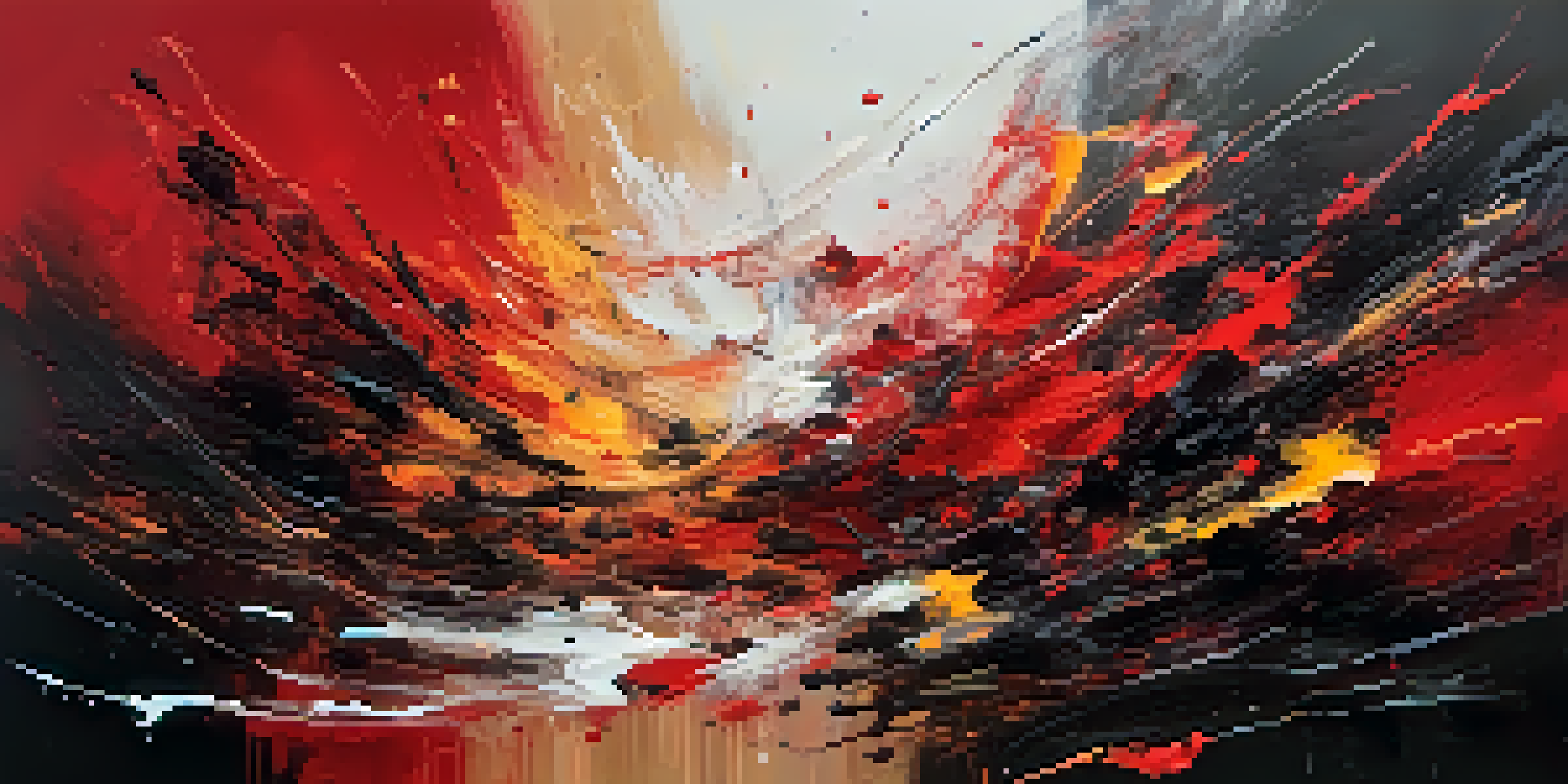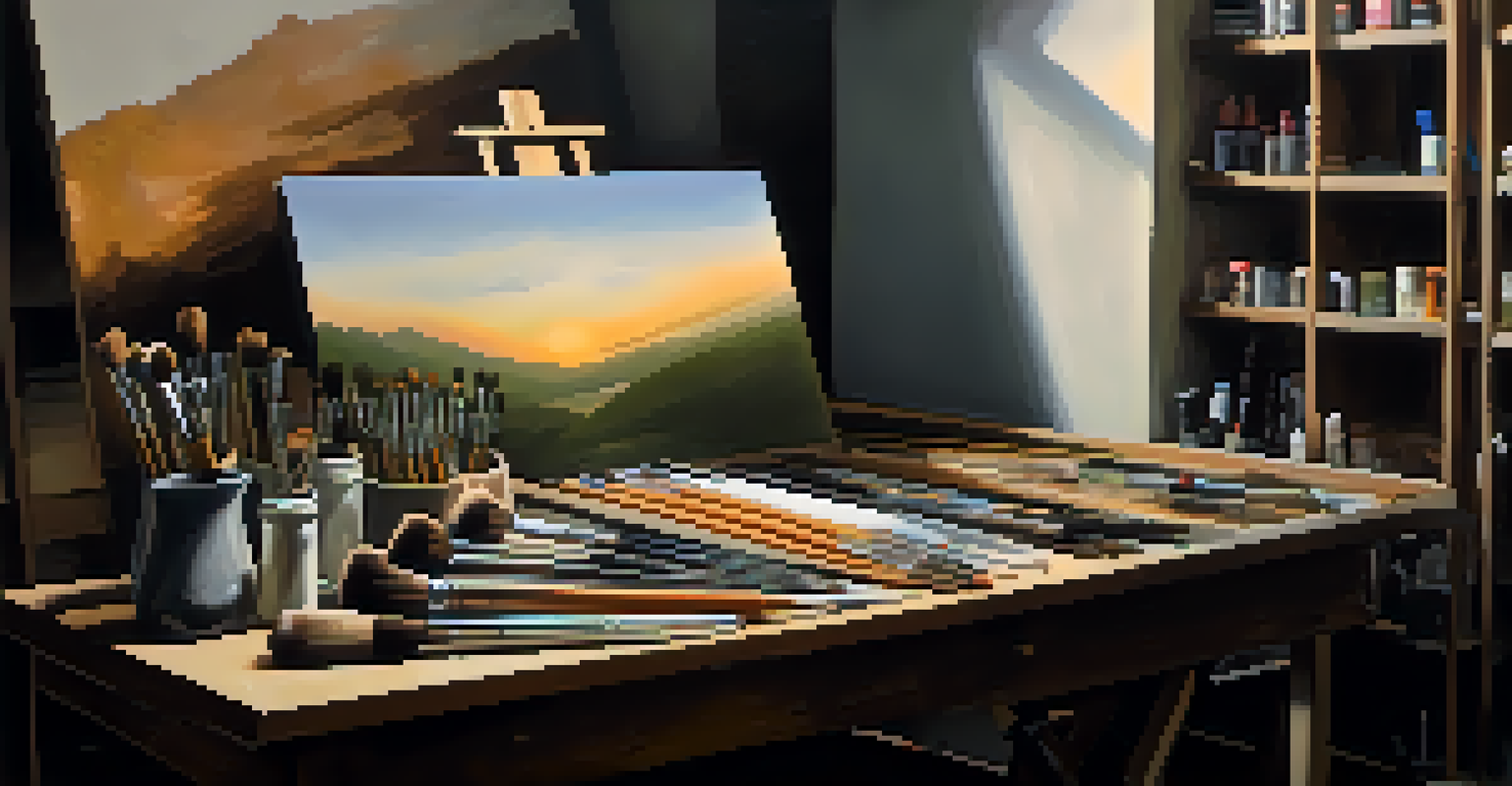Brush Techniques: A Guide to Expressing Complex Emotions

Understanding the Connection Between Art and Emotion
Art has a unique ability to express emotions that often elude words. When we create, we tap into our feelings, allowing our brush strokes to translate our inner world onto the canvas. Whether it's joy, sorrow, or confusion, the act of painting becomes a dialogue with ourselves, revealing layers of complexity.
Every artist dips his brush in his own soul, and paints his own nature into his pictures.
For instance, think of a stormy sky painted in dark blues and grays. The colors alone can evoke feelings of unease or turmoil, much like how we feel during a rough patch in life. This connection between color, technique, and emotion is what makes art so powerful and relatable.
Understanding this connection can enhance your painting practice. By becoming aware of your emotions and how they influence your brushwork, you can create art that resonates not only with you but also with those who view it.
Choosing the Right Brushes for Your Emotional Palette
The type of brush you use can significantly impact the emotions portrayed in your artwork. From soft, rounded brushes that create gentle strokes to stiff, flat brushes that deliver bold lines, each brush can express a different sentiment. It's essential to consider how these tools can help convey the feelings you want to express.

For example, a fan brush can create beautiful textures that evoke feelings of nostalgia, while a palette knife can introduce harsh edges that might represent anger or frustration. Choosing the right brush isn't just about technique; it’s about the emotional impact you wish to achieve.
Art as Emotional Expression
Art uniquely conveys emotions that words often can't capture, allowing for personal reflection and communication.
Experimenting with various brushes can lead to surprising discoveries about your emotional expression. Don't hesitate to explore different styles and strokes to find what resonates with you.
Color Theory: The Language of Emotions in Art
Color is a powerful communicator in art, often conveying emotions that words cannot express. Understanding color theory, which explores how colors interact and the feelings they evoke, can enhance your ability to express complex emotions. For instance, warm colors like red and yellow can evoke feelings of warmth and happiness, while cool colors like blue and green can convey calmness or sadness.
Art is the most beautiful of all lies.
Imagine painting a scene using fiery reds and oranges to represent passion or excitement. In contrast, using cool, muted colors can evoke a sense of melancholy. The choice of color can transform an ordinary piece into a profound emotional experience.
By mastering color theory, you can make deliberate choices that enhance your artwork's emotional depth. This understanding allows you to craft a visual story that resonates with viewers on a deeper level.
Brush Techniques for Expressing Specific Emotions
Different brush techniques can be employed to convey specific emotions effectively. For instance, quick, frenetic strokes can express anxiety or agitation, while slow, sweeping motions might evoke tranquility or reflection. The rhythm of your brushwork can mirror the emotional state you wish to convey.
Consider the technique of dry brushing, which can create a rough texture that adds intensity and urgency to your work. Conversely, glazing can produce a soft, ethereal quality that might evoke feelings of nostalgia or dreaminess. Understanding how to manipulate these techniques allows for greater emotional expression.
The Impact of Color Choices
Understanding color theory enhances emotional expression in art, as different colors evoke distinct feelings.
Practicing various techniques will enable you to find your unique voice as an artist. The more you experiment, the more adept you'll become at using your brush to express complex emotions.
Layering Techniques to Build Emotional Depth
Layering is a technique that can add depth and complexity to your artwork, both visually and emotionally. By applying multiple layers of paint, you can create richness in texture and color that draws the viewer in. Each layer can represent a different emotion or aspect of a feeling, creating a multifaceted experience.
For example, a base layer of dark colors can signify sadness, while subsequent layers of brighter colors can signify hope or healing. This method allows you to tell a story through your brushwork, revealing the evolution of emotions over time.
Incorporating layering into your artistic process can transform your approach to emotional expression. It encourages a deeper exploration of your feelings and how they manifest visually.
The Role of Abstract Techniques in Emotional Expression
Abstract art often relies on unconventional techniques to express emotions that are difficult to articulate. By breaking away from realistic representations, artists can focus on feelings and concepts, using color, shape, and texture to communicate their inner experiences. This freedom allows for a more personal and profound expression of complex emotions.
For instance, using splashes of color and chaotic brushstrokes can convey feelings of turmoil or excitement. Alternatively, smooth, fluid shapes might represent calmness or serenity. The lack of defined forms gives viewers the opportunity to interpret the emotions based on their perceptions.
Techniques for Emotional Depth
Using various brush techniques and layering methods can significantly deepen the emotional complexity of your artwork.
Exploring abstract techniques can be liberating, allowing you to experiment with emotional expression in an unbound way. Don't be afraid to step outside the lines; your feelings are valid, and your art should reflect that.
Reflecting on Your Artistic Journey and Emotions
Art is not just about the final product; it's also about the journey you take while creating. Reflecting on your emotions during the process can provide valuable insights into your artistic evolution. Keeping a journal or sketchbook to document your feelings can help you understand the relationship between your emotional state and your artistic choices.
For example, if you notice that you tend to use darker colors when feeling overwhelmed, you can explore this further through your art. This reflection can lead to more intentional choices in your work, allowing you to express emotions more authentically.

Ultimately, your artistic journey is a personal exploration of emotions. Embrace this journey, and let your brush techniques serve as a voice for the complex feelings that shape your experience.